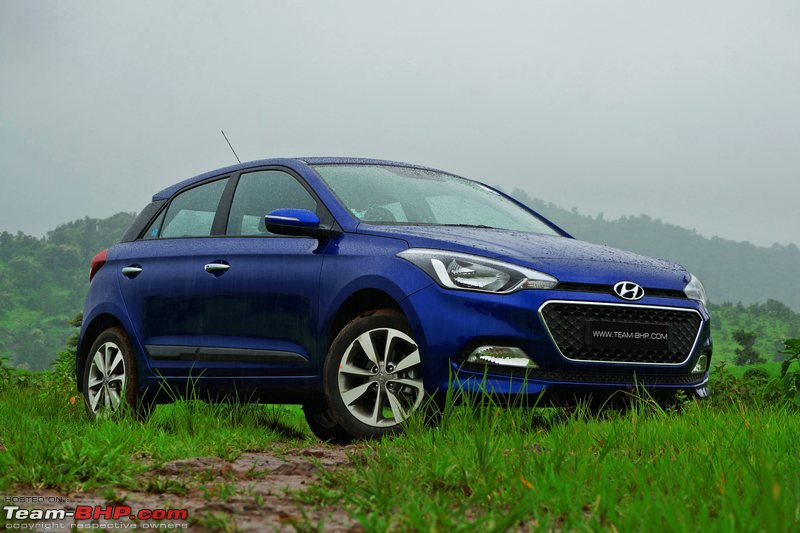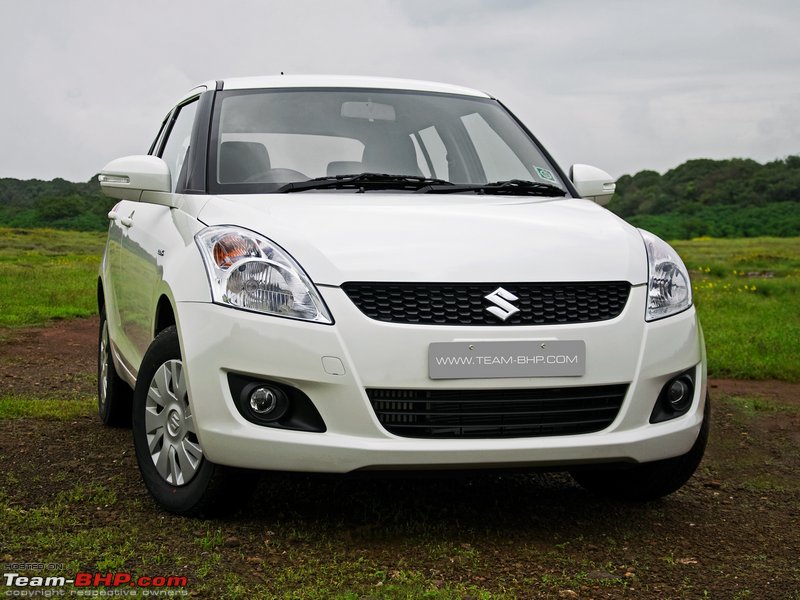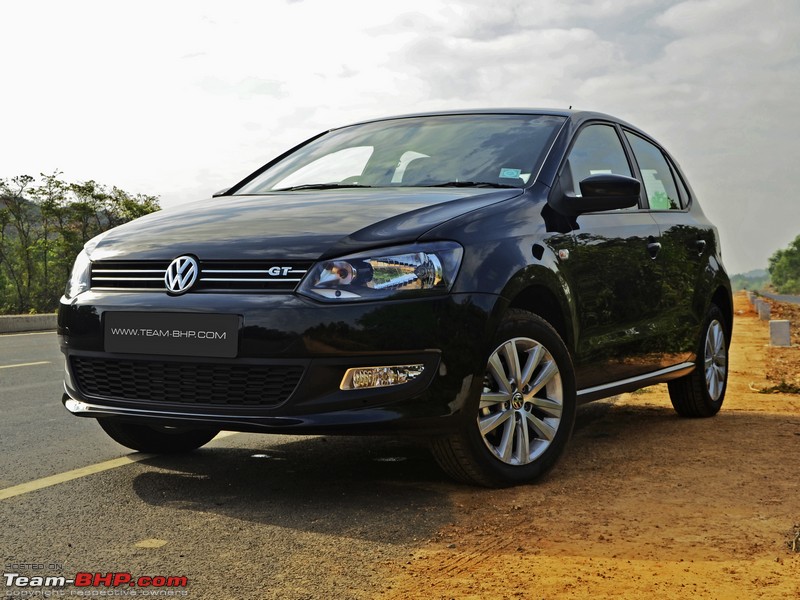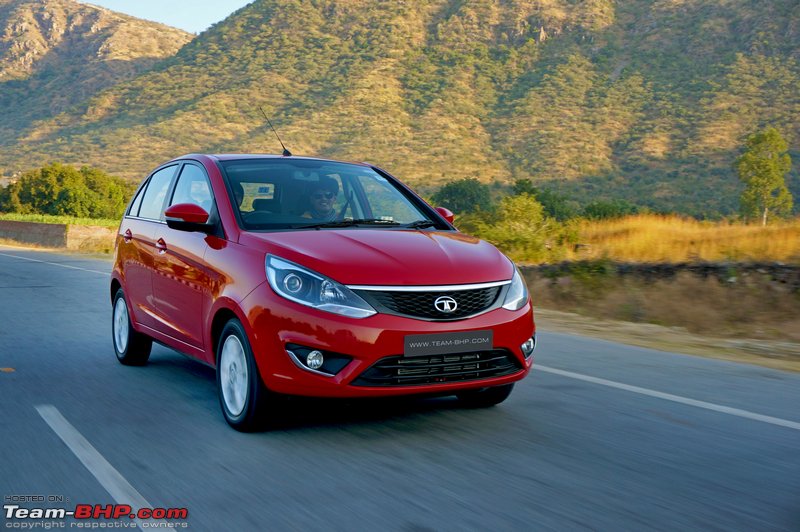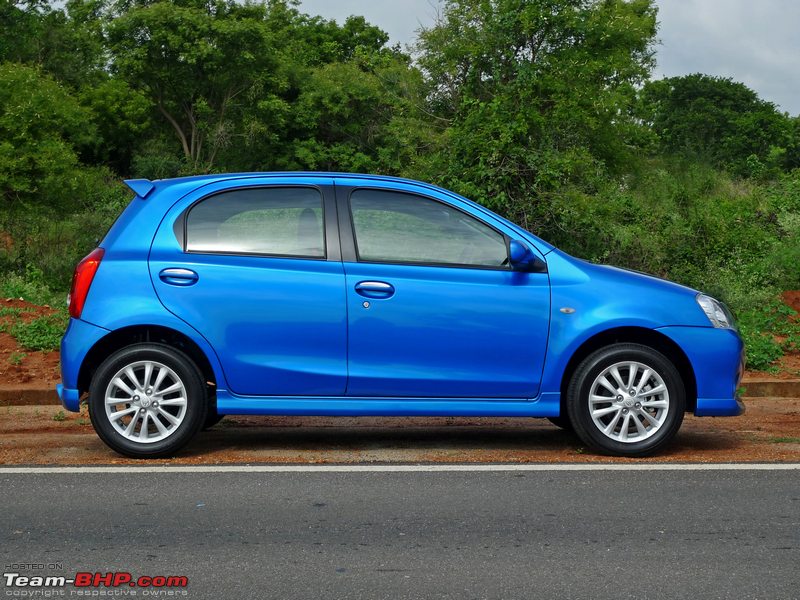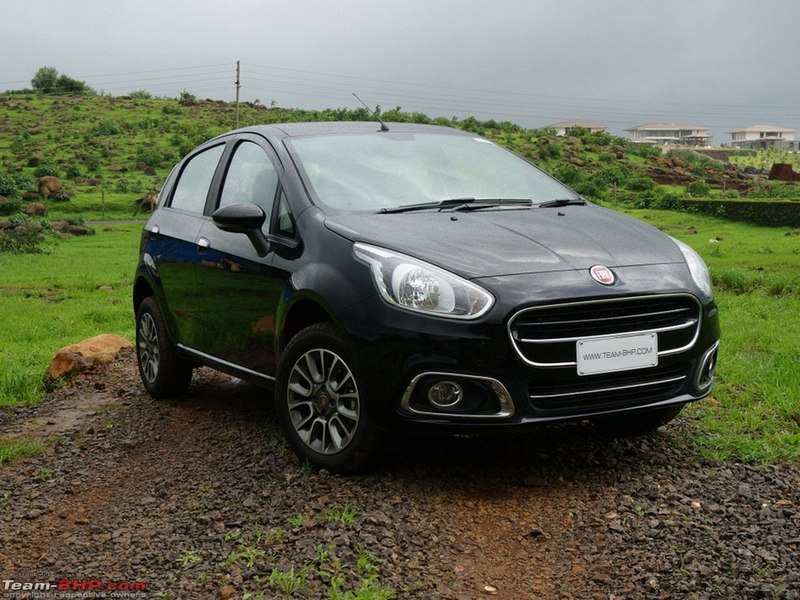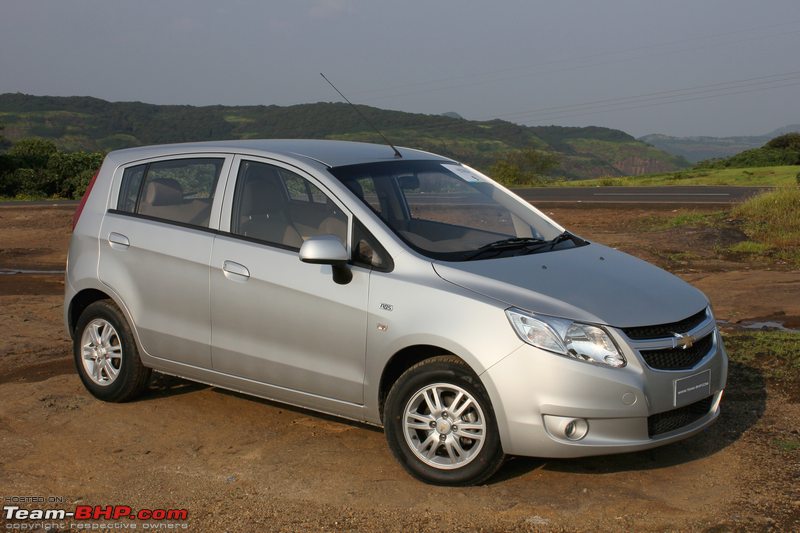| |||||||
| Search Forums |
| Advanced Search |
| Go to Page... |
 |
| Search this Thread |  3,636,979 views |
| | #1 |
| Team-BHP Support  Join Date: Aug 2009 Location: Bangalore
Posts: 9,157
Thanked: 14,549 Times
| Honda Jazz : Official Review The Honda Jazz has been launched in India at a price of between Rs. 5.31 - 8.59 lakhs (ex-Delhi). What you’ll like: • Versatile package wearing sharp clothes. One car for several roles • Spacious, user-friendly cabin. Easily the roomiest hatchback in India • Big 354 liter boot is the segment best. Magic seats bring tons of flexibility • Practical & efficient diesel, refined & revv-happy petrol and a convenient CVT. Take your pick • Comfortable ride quality. Much improved over the older Jazz • Light controls and easy maneuverability. Effortless to drive in the city • Features such as feather-touch climate control, reversing camera, touchscreen ICE, paddle shifters (CVT) & more What you won’t: • Loud diesel engine is nowhere as refined as the Elite i20's. Doesn't like high rpms either • 1.2L petrol has a weak bottom end. Feels lethargic <2,500 rpm • On-road premium for diesel is Rs. 1.3 - 1.5 lakhs! That's higher than the competition • Magic seats only on the top variant (earlier Jazz had them on all trim levels) • CVT unavailable with the VX trim! No fully loaded Automatic • Skinny 175 mm tyres. All competitors offer thicker rubber (Elite i20 = 195 mm) • Missing goodies (steering reach adjustment, keyless entry & go, rear air-con vents, driver armrest & proper dead pedal) Last edited by GTO : 8th July 2015 at 18:22. |
| |  (101)
Thanks (101)
Thanks
|
| The following 101 BHPians Thank suhaas307 for this useful post: | .anshuman, 9thsphinx, Added_flavor, aeroamit, ampere, anilkumar, arif_iq, ashpalio, AutoIndian, BaCkSeAtDrIVeR, carrazy, CrAzY dRiVeR, dalwani, damager21, dean5545, deb_majumdar, deetjohn, DetonatoR, DevendraG, dhanushs, Dr.AD, drift2race, ecosport rules, frankmehta, Gannu_1, gpa, Grand Drive, gschandra, GTO, haisaikat, harsh79, hellmet, hemanth.anand, iliketurtles, jeet8686, jeetaman, joednazareth, JoseVijay, kat, lemedico, libranof1987, lollapalooza, mandywanders, MDED, Mevtec, mh09ad5578, mrbaddy, myavu, neil.jericho, nikipedia87, Nohonking, noopster, paragsachania, parsh, phamilyman, quick_silver, rav11stars, RavenAvi, recshenoy, reihem, riturajsharma19, rshanker, RSR, S.MJet, S2!!!, samabhi, sanstorm, Sarmaji, SchumiFan, scopriobharath, Sheel, shipnil, Simhi, SmartCat, sqs103, SS-Traveller, StepUP!, Suchu90, swiftnfurious, Technocrat, The Observer, theexperthand, themonster, theredliner, timussharma, Turbo_asd, Tushar, uday.ere, Varun_HexaGuy, vb-saan, VeluM, vibbs, Vid6639, Vigkey, Viju, vikred, VinNam, Voodooblaster, vsrivatsa, Wildy, yosbert |
| |
| | #2 |
| Team-BHP Support  Join Date: Aug 2009 Location: Bangalore
Posts: 9,157
Thanked: 14,549 Times
|  Honda entered the hatchback space 6 years ago with a competent product, the 2nd generation Jazz. It was a chic, spacious and versatile little car that was capable of several roles, thanks to its clever packaging. Equally, the Jazz symbolised all that was wrong with Honda at the time. Ask me, I'm an owner of the ol' Jazz. It was overpriced, poorly equipped and didn't have a diesel option. The Hyundai i20 offered to the market what the Jazz didn't. As just one example, the Hyundai had 6 airbags while the Honda didn't even get alloy wheels!! From being perceived as an expensive hatchback initially, the i20 suddenly became value-for-money after the Jazz' pricing was announced. Fact is, i20 sales shot up after the launch of the Jazz. Refreshed and better-equipped Jazz variants didnít help matters and it remained a sales dud. Prices were slashed in order to move surplus stock, and Honda finally pulled the plug on the Jazz in 2013. With the new 3rd generation Jazz, Honda intends to change that. This time around, you can choose from 3 engine & transmission combinations, including a diesel mated to a 6-speed manual gearbox and a petrol CVT Automatic. India is the first market to get the Jazz 1.5L diesel and the configuration will remain exclusive to us for now. Honda has already begun its export operations too, with the Jazz 1.5L i-VTEC being shipped to markets like South Africa. The car will also be heavily localised; 90% in the new generation as opposed to 70% of the old. This helps bring manufacturing costs down. And it's not just the costs or pricing. This Jazz has a better shot at success because the big hatchback market has matured now. The segment practically didn't exist in 2009! The overall dimensions are similar to the old car. At 3,955 mm, it's 55 mm longer than the outgoing Jazz, but 30 mm lesser than Hyundai's Elite i20. It's about 40 mm narrower than the Hyundai too (measuring at 1,694 mm) and taller by 39 mm at 1,544 mm. The Jazz shares its platform with the Honda City. Walk up to it and the first thing that strikes you is the mini-MPV look. Honda calls this a 'Crossfade Monoform Design' which essentially means that it's one cohesive form, unlike conventional cars that are classified as two-box or three-box vehicles. The company has clearly taken an evolutionary approach while designing the new Jazz. The styling is a throwback to the old car's MPV'ish design, with some aggression dialled in. The sharp cuts & angular lines are in line with Hondaís current design language. I feel itís a welcome departure from the old carís curvier image. That said, the stance remains heavily cab-forward. The glass area is huge, especially with the massive front windscreen and quarter-glass windows that should have had their own power window switches! The styling is definitely a bit eccentric and it's not universally appealing like the Elite i20. Admittedly, the Jazz has always looked like a bit of a blob on wheels. That said, while the design may divide opinions, it's not off-putting or offensive. The front-end is dominated by a large black grille and a touch of silver. I like this face better than the City's which wears way too much chrome. In fact, Honda seems to have avoided garnishing this car with large doses of chrome, except for the hatch that wears a wide chrome strip. What you'll also notice at the rear is the big spoiler. The side profile has been given a strong belt line / ridge that makes it look less slab-sided. Panel gaps are even for the most part, while paint quality and exterior fit & finish are good. Overall, the new car feels well screwed together. Look closely and you can spot some inconsistencies though. The bonnet, for one, had an irregular gap on a few of the media cars. This wasn't the case with the older Jazz, although it's more uniform than some early examples of the City which had the boot, bonnet and doors misaligned. The build quality feels better than the old Jazz which is tinny in comparison. The doors of the new Jazz might be light, yet they open and shut with a reassuring clunk. Just don't expect Euro-like solidity. This clunk isn't even as 'clean' as the Elite i20's. The new Jazz looks sharper than ever. Will appeal to mass market tastes. Large piano black grille dominates the front end. I'm glad that it doesn't have the City's excessive chrome here: 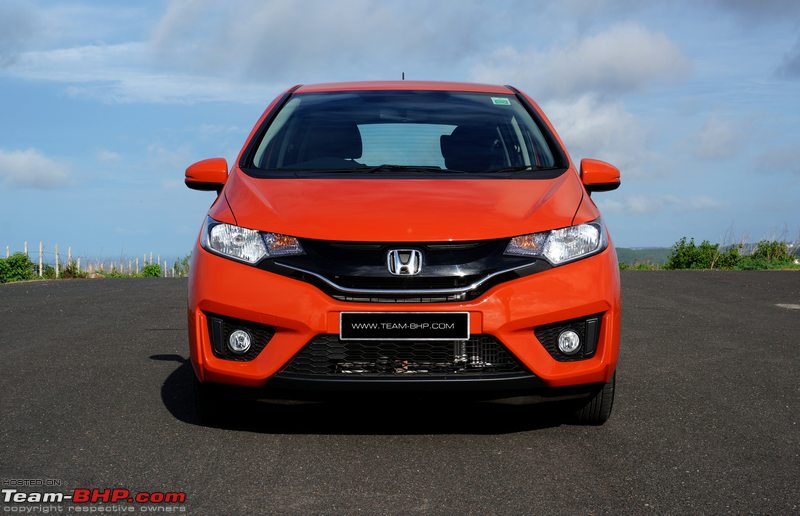 No escaping the massive chrome strip at the rear though. Isn't to my taste. Those unusual vertical reflectors look very Volvo-esque. Tail-pipe barely visible: 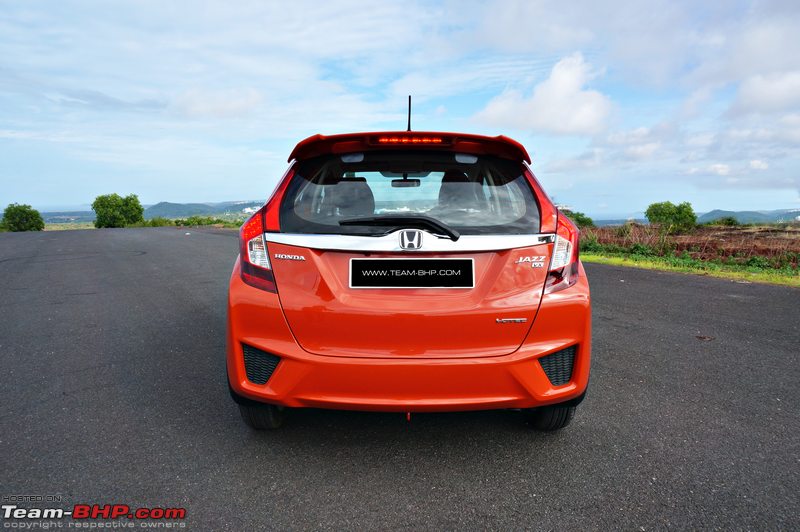 MPV-like silhouette isn't necessarily a bad thing. Wheelbase has increased by 30 mm, whereas overall length is up by 55 mm...liberating even more space inside the cabin: 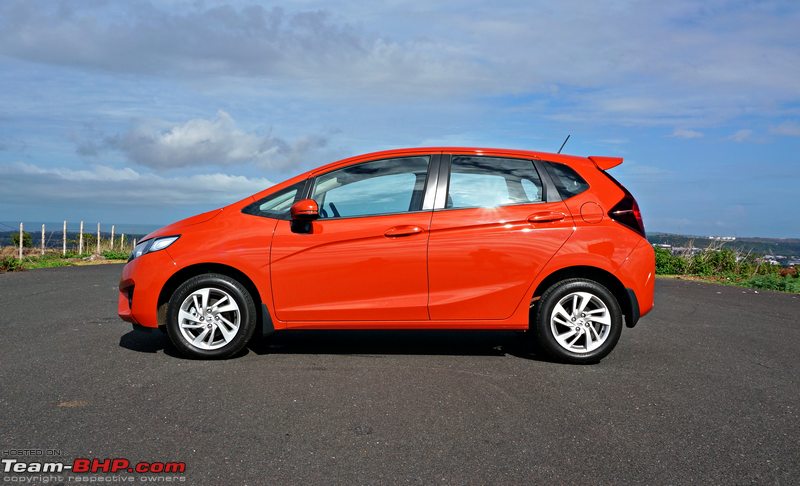 The older Jazz had some cuteness to its design. The 2015 model drops that image, and looks edgier / sportier: 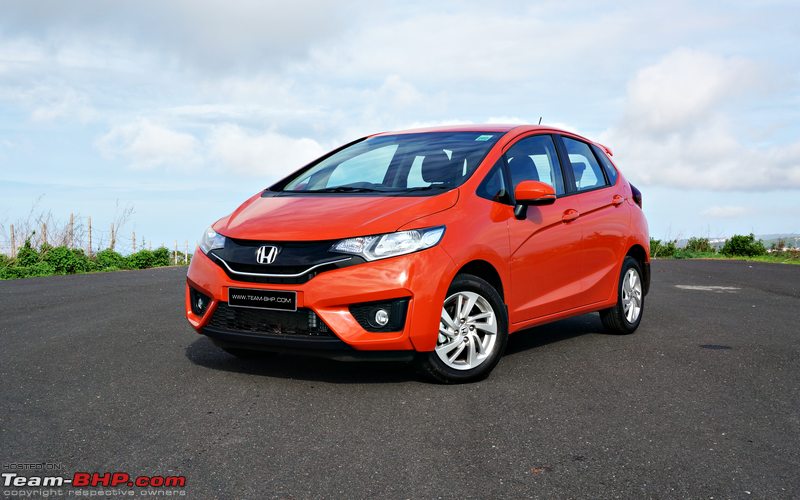 Viewed from such angles, the 15" wheels look too small & the tyres too skinny for all that sheet metal. 14" rims of the lower variants will look even more puny: 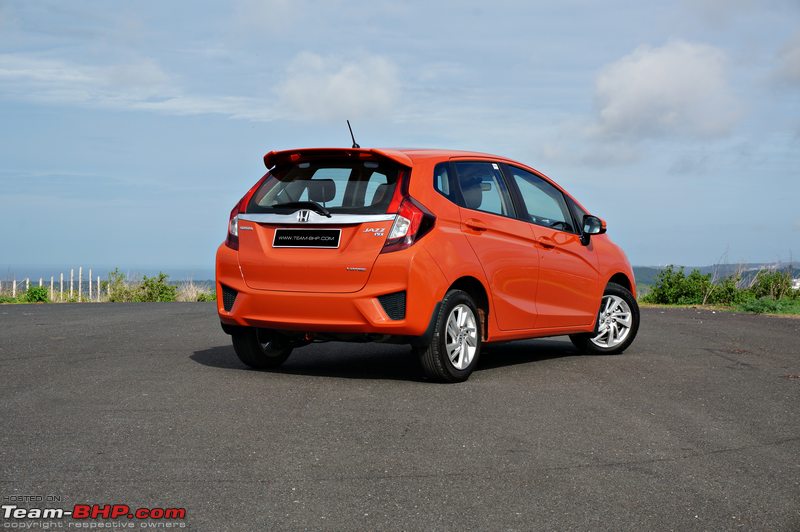 Headlights are smart and contemporary, a refreshing departure from the caricature-like units of the old Jazz. They house a single H4 bulb vs the City's double-barrel lights:  Panel gaps are small for the most part, but they aren't perfect. The bonnet on a few of the cars had a bigger shut line than expected. Still, the panel gaps are actually more consistent than the City's!  A closer look at the face. The piano black grille with slim chrome lining, along with the blackened air-dam, add to the appeal:  Unlike the previous gen, foglamps are now positioned closer to the corners. Notice the provision for daytime running lights. Will come in the facelift, perhaps? 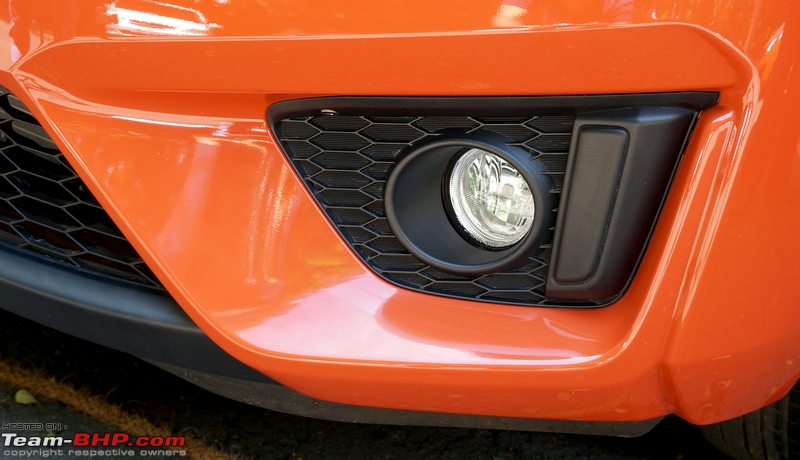 The windshield is still XXL-sized. That plastic shroud discreetly houses the windshield washers:  15" rims look eons better than the boring ones of the Honda City. These bear an uncanny resemblance to the pre-facelift Swift's alloys:  Electrically-foldable ORVMs with integrated turn indicators have been nicked off the City:  Grab-type door handles feel more solid than the dinky flaps on the old Jazz. Keyhole looks lost on the door. Should have been integrated with the door handle:  Strong ridge / belt-line running across the side and flowing into the tail lights is a typical Honda design trait. Looks sharp:  This large rear spoiler is exclusive to the top-end VX variant. Not only does it help distinguish it from the lower variants, the spoiler also makes the Jazz look less rear heavy. While the windshield washer is integrated into the rear spoiler here, you'll find the washer neatly tucked into the 3rd brake light of the V: 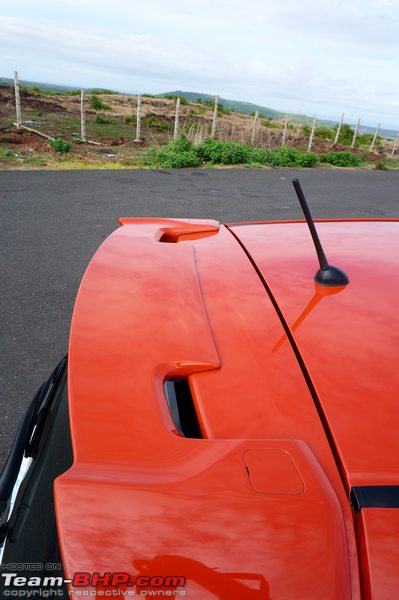 The tail lights are now home to LED bulbs! Candlestick tail light extensions are actually reflectors: 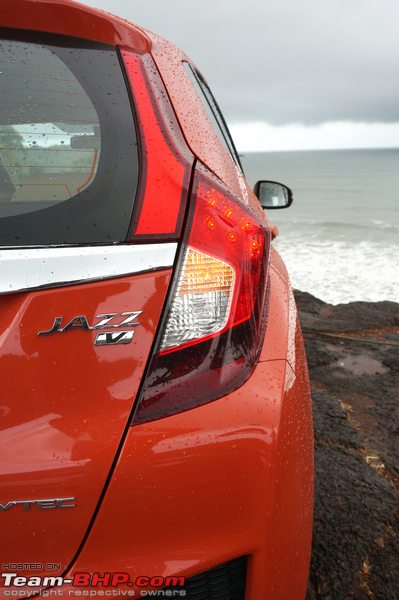 Rear bumper doesn't protrude out. For namesake only? A rear impact will easily dent the hatch:  Antenna is on the shorter side and looks better than the Elite i20's ungainly piece: 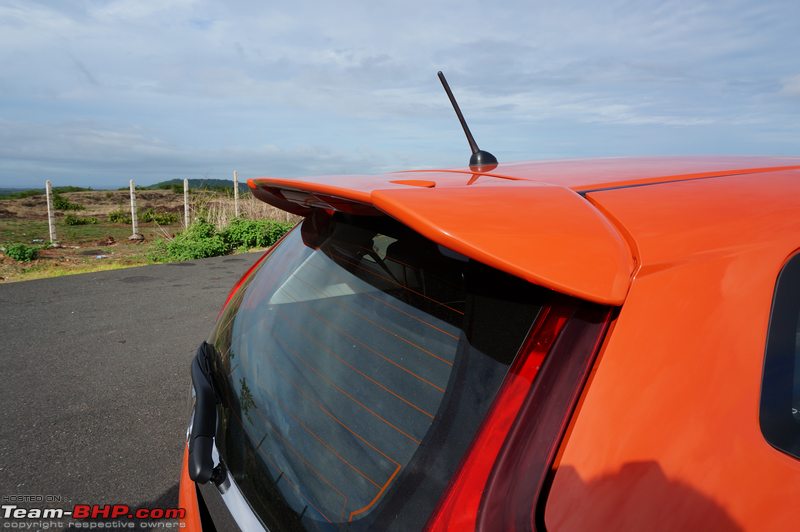 A glance at the lower V variant which doesn't get a spoiler:  Variant badging is now similar to other Hondas (old Jazz had variants named 'Select' & 'X'). It sits below the model name (side by side in the City):  The Jazz gets a diesel engine for the first time since its inception in 2001. You'll only see the i-DTEC badge in India, as no diesel Jazz is offered anywhere else in the world. Period:  Swoopy, chunky rear wiper: 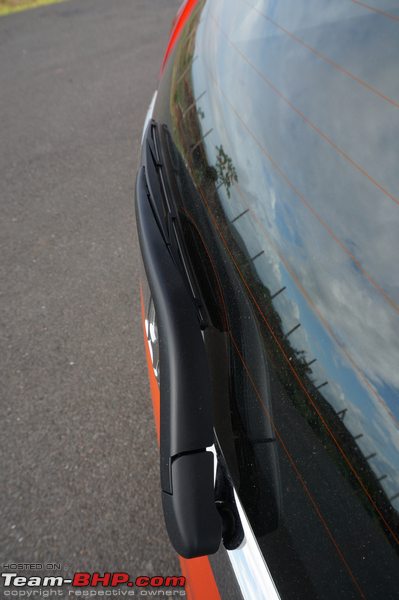 Reversing camera neatly tucked under the chrome garnish:  Faux honeycomb vents have been inserted at the bumper corners specifically to break the body bulk at the rear. They are rather big:  Not too far off in terms of dimensions, yet the design language of these cars are at different ends of the spectrum:  The Jazz has its work cut out. The Elite i20 is brilliantly packaged and a formidable opponent:  Goa has its own charm during the monsoons. Take a look at this beautiful spot we found. New sunset orange hue is striking...and the designated shade for Honda's marketing campaign:  Last edited by GTO : 20th July 2015 at 15:30. Reason: Updating Jazz Diesel kerb weight in the excel sheet |
| |  (87)
Thanks (87)
Thanks
|
| The following 87 BHPians Thank suhaas307 for this useful post: | --gKrish--, .anshuman, AbhishekE, Added_flavor, AdityaDeane, Aficionados, Anand123, arif_iq, ashpalio, AutoIndian, carrazy, CrAzY dRiVeR, DevendraG, devilwearsprada, dhanushs, Dr.AD, ecosport rules, gostel, gpa, Grace, gschandra, GTO, harsh79, hellmet, hemanth.anand, InControl, IronH4WK, itsashishsharma, jeetaman, jetti, JoseVijay, Latheesh, lemedico, libranof1987, lloydofcochin, MDED, Mevtec, mh09ad5578, mrbaddy, MSAneesh, myavu, Nohonking, noopster, paragsachania, parsh, PearlJam, phamilyman, RavenAvi, recshenoy, rshanker, RSR, Ryuu, S2!!!, Safedriver76, saisree, samabhi, SatishBisht, SchumiFan, scopriobharath, searacer932, Sheel, shetty_rohan, Simhi, SmartCat, Soumyajit9, sqs103, Sreesh1009, sups, swiftnfurious, Technocrat, The Observer, theexperthand, themonster, theredliner, Tushar, uday.ere, Varun_HexaGuy, vb-saan, VeluM, vibbs, Vid6639, Vigkey, Viju, vikred, Voodooblaster, Wildy, yosbert |
| | #3 |
| Team-BHP Support  Join Date: Aug 2009 Location: Bangalore
Posts: 9,157
Thanked: 14,549 Times
| Interior - Front 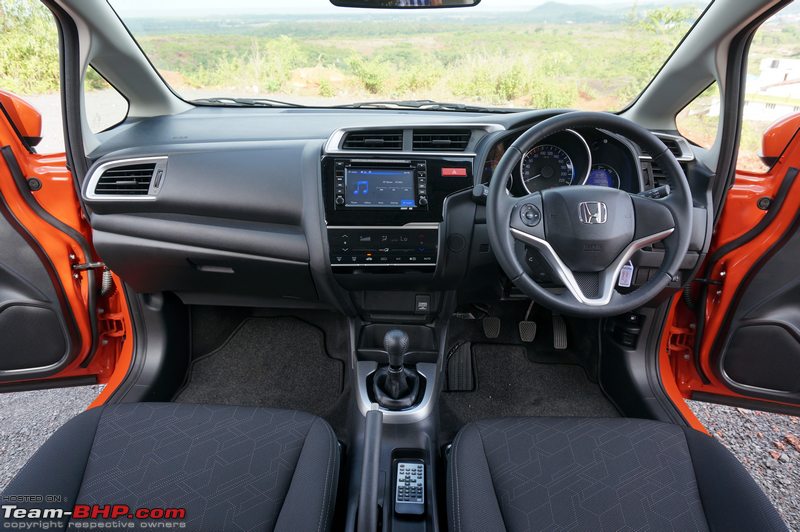 Step into the Jazz and you'll be greeted by a familiar looking dashboard & steering wheel. To the untrained eye, the interiors would look just like the City. Yes, they are similar to its sedan sibling, but far from being the same. The all-black interior (VX only) is refreshing in the wake of the beige / greige we see in every other car nowadays. Vid6639 and I think that the black interior not only looks better than the beige of the lower variants, it also feels better. Fit and finish are decent for the most part, although some of the plastics are of a hard and scratchy variety. Unless you're a real stickler for quality, there isn't much to fault. No, you won't find apparent signs of cost cutting. The headlight / wiper stalks are nice to use and have a damped quality to them. The lower half of the interior does suffer from average quality bits though. Some of the plastics in the footwell area are merely budget-grade. The handbrake is made of hard plastic in the new Jazz, where it was rubberised in the older car. What dilutes the premium feel are the numerous dummy switches in the cockpit. This includes a round plastic cap that plugs the spot where the engine start button is supposed to be! The export Jazz gets this feature...we only get a cap!! The Elite i20 is still the benchmark for B+ segment hatchbacks as far as quality & finesse are concerned. It feels way more premium than the Jazz - the Hyundai's cabin feel is truly exceptional. In fact, I'd go so far as to say that even the Grand i10's interior quality feels more premium than the Jazz. That is saying something about modern day Hyundais. The front doors open 90 degrees and in three stages, making ingress / egress fairly easy. Once you get in, you'll notice the incredibly massive glass house. The large windscreen, huge windows and front quarter-glass give this cabin an airy feel, in spite of the interiors being all-black. I found the driver and passenger seats to be wide and fairly supportive. The seat squab is now angled correctly, unlike the old car's squab that was parallel to the floor. This helps a great deal with under-thigh and lumbar support. While the old car's seats feel more like chairs, the new Jazz gets proper seats into which you sink nicely. Vid6639 commented that the beige front seats in the 'V' weren't as comfortable as the black seats of the 'VX'. It's also worth noting that Honda bucks the trend when it comes to seat thickness. Most hatchbacks these days come with thin seats, but not the Jazz! These are thicker than the norm. The fabric upholstery is pretty nice, and the doorpads get some of that fabric material too. Space up front was never going to be a problem with the Jazz. Its cabin feels wider than most cars in the class. Honda claims that shoulder room for front occupants is up by 35 mm. Legroom is more than you'd ever need, and it's the same story with the headroom as well. While lateral visibility is fantastic, frontal visibility can be a pain around a junction / corner due to the fat A-pillars & quarter glass design. This creates serious blind spots. The ORVMs are big and lend you a good view of the action behind. However, while the IRVM shows you as much as it can, the rear pillars seriously mar visibility. You'll have to be cautious when reversing into your parking slot. The ergonomics are perfect and everything falls into place easily. This is a user-friendly car. The steering wheel is straight out of the City (without the cruise control). The steering's leather wrap offers satisfactory grip. While the steering wheel adjusts for rake, there is no provision to adjust it for reach. Vid6639 found this particularly annoying as his driving position is comparatively more relaxed. It's noteworthy to mention that the Elite i20 offers steering reach adjustment. On the flip side, the driver's seat height adjustment can go to extents you wouldn't believe! It'll easily accommodate the shortest & tallest of drivers. No driver armrest...it'll be sorely missed, especially in the AT variant. The instrument cluster isn't too different from the one in the City. The dials are clear and easy to read on the move. Just like the old Jazz, the new one also has a real-time fuel efficiency display. FE fans will love how the graphical bar moves with a light foot. Like its sedan counterpart, the Jazz has ambient cluster lights that glow green if driven sensibly (blue colour when you don't). You get an average FE display and a distance-to-empty readout too. Like all Hondas, the instrument cluster remains illuminated during the day. Honda has ditched those funky space-pod A/C controls of the old Jazz for a cleaner, less cluttered center console that is reminiscent of the current City. The feather-touch controls are nice to use once you get a hang of them. You need to take your eyes off the road to change climate control settings though. Because of the monsoons, we can't comment on the air-con's effectiveness and will leave final verdict to our ownership reports. Honda's air-cons are usually powerful, hence we have no concerns in this area. The piano-black panel around the ICE is tasteful, although there are reflections under sunlight. It's a big fingerprint magnet as well. The V variant gets a 5 inch head-unit while the VX has a 6.2 inch touchscreen. Both head-units are equipped with Bluetooth, USB and Aux, along with steering mounted controls. In the VX, the cables are routed through the glovebox and packed into a pouch. In the V, the ports are placed on the center console (at the bottom). Interestingly, the iPod cable offered in the VX is the old one! The Bluetooth system doesn't allow you to pair phones while driving. Personally, I prefer the 5-inch unit as it looks well-integrated into the facia, and blends in with the layout of the center console nicely. On the other hand, the touchscreen ICE looks like a cheap aftermarket add-on. The touchscreen interface itself isn't particularly user-friendly. While it's fairly quick to respond, the interface belongs to the '90s. The VX comes with a handy remote control for the ICE. Navigation is also provided on the VX variant. We found it awful to use, and chose our smartphone's maps instead. The ICE doubles up as a display for the reversing camera. Ironically, only in the 5 inch ICE of the V variant, you get 3 viewing options (Normal, Wide and Top). The VX's reversing display offers only one standard view. The parking display shows static guidelines (Elite i20 displays adaptive guidelines). What took us by surprise is the sound quality from the 4-speaker ICE. It's nice for a stock factory system. The bass is punchy and the clarity is good. There wasn't any jarring at higher volumes either. Most owners will never feel the need to upgrade this ICE. Practicality is one of the Jazz' stronger points and we found innumerable, conveniently placed cubbies. There are a total of 9 cup / bottle holders in here. Each door gets a bottle holder; the front ones are bigger and a 1L bottle might just about squeeze in, but they're really best for the 500 ml variety. The door pockets are useable when they're not carrying bottles. Place a Bisleri and there's not much space for anything else. The driver's air-con vent has a can / bottle holder right in front of it to keep drinks cold (old Jazz had one for the front passenger as well). The glovebox' size is standard fare, nothing impressive. You'll remember that the last Jazz had two gloveboxes (one on top of the other), but the new Jazz only has one. Also gone is the useful crevice between the twin gloveboxes. Ahead of the gear lever are two cupholders and a big storage area that can take a 5.1" smartphone lying flat. Then, to the right of the handbrake are two cubby holes, one deep and the other shallow. Behind the handbrake are two more storage spots, one of which can host a 1L water bottle. Interior theme is similar to the City (but far from identical). The dash definitely suffers from asymmetry (its design lacks cohesiveness). The VX's all-black look is refreshing in a market obsessed with beige. Enormous glass area makes even this black cabin feel airy: 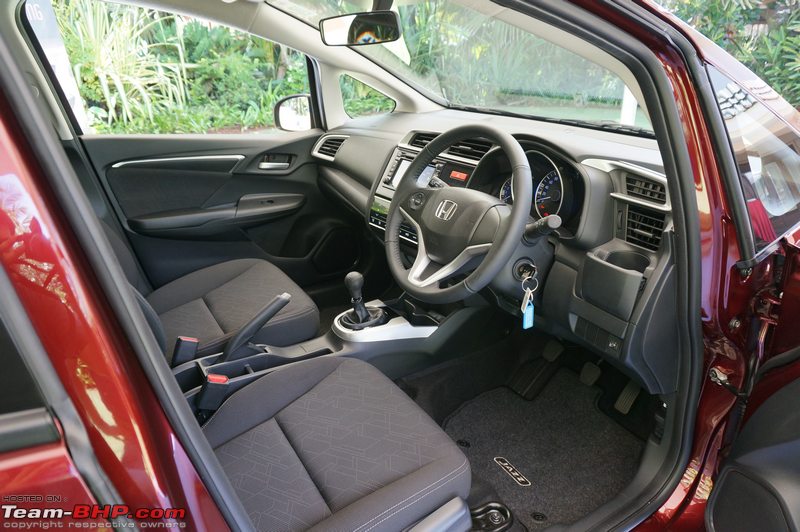 Nice steering wheel shared with the City (sans the cruise control buttons). No contours for your thumbs though. Shockingly, it only offers tilt adjustment, not telescopic. Such practical features shouldn't be missing in a premium hatchback:  Basic audio controls on the left:  Telephony buttons are placed behind. Very easy to use:  Dials are similar to the City's, but don't get the illuminated blue rings. The speedometer also has a huge shroud here. To toggle through the MID, you need to use the stalk that's located at the top right. A steering / stalk mounted button would be preferred:  Instantaneous FE bar is always visible on top - efficiency fans will love the feature. It's inversely proportional to the revv counter  . MID shows you the distance to empty, as well as the average FE for each of the 2 trip meters: . MID shows you the distance to empty, as well as the average FE for each of the 2 trip meters: Chunky stalks are standard Honda fare:  Front seats are very comfortable, while the driver's seat height adjustment has a long range. Unlike the cheap Amaze / Brio seats, these aren't slim. They are thick enough:  Seat height adjuster is sturdy:  Zooming in on the black seat fabric. Feels like a hard wearing material, and the white stitching gives it a sporty look:  Doorpads are so much better (design-wise) than the City's bland units. They also feel more solid. Nope, unlike its sedan sibling, they don't flex when you roll the windows up or down:  The silver strip and cloth padding lend a premium touch to the doorpad. Sadly, the base where you rest your elbow isn't padded:  Standard switchgear for the power windows and ORVMs. Yup, the ORVMs are electrically foldable. Only the driver's window gets the auto up / down feature. There's a silly dummy cover where Hondas usually have the central lock / unlock switch (sample):  Side air-con vents get dials that can shut the air flow completely:  Useful cup-holder to park that Coke can in front of the cold air vent. The cup-holder is adjustable for larger bottles as well. Neat!  ABC pedals are positioned perfectly. Lame excuse for a dead pedal though. It's just a crude piece of rubber stuck onto the carpet. Believe it or not, the fake dead pedal went loose in our test drive, and one reviewer ended up with his shoe sticking to the glue! In this picture too, you can tell that it has moved from its original position:  Bonnet & fuel lid release levers. The hatch is linked to the car's central locking system:  Egad! A dummy cap that will always remind you what Honda didn't give you. No variant of the Jazz comes with an engine start / stop button. Come on Honda, even the Swift & Grand i10 get one now: 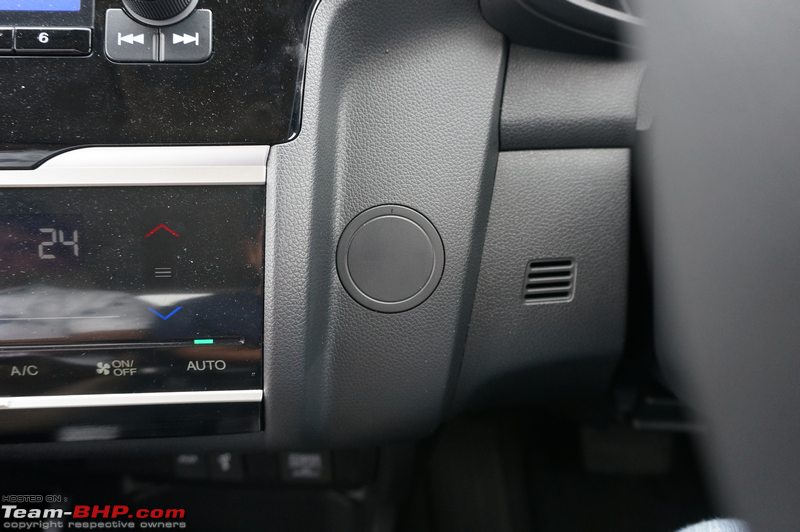 Piano-black finish is tasteful, but it is a fingerprint magnet. 6.2" touchscreen head-unit (featuring DVD playback) looks like an aftermarket add-on. The 5" non-touchscreen unit (of the lower variant) looks better integrated with the console. This touchscreen model is the same one that was earlier rejected in the Mobilio due to bugs. We didn't like its interface: 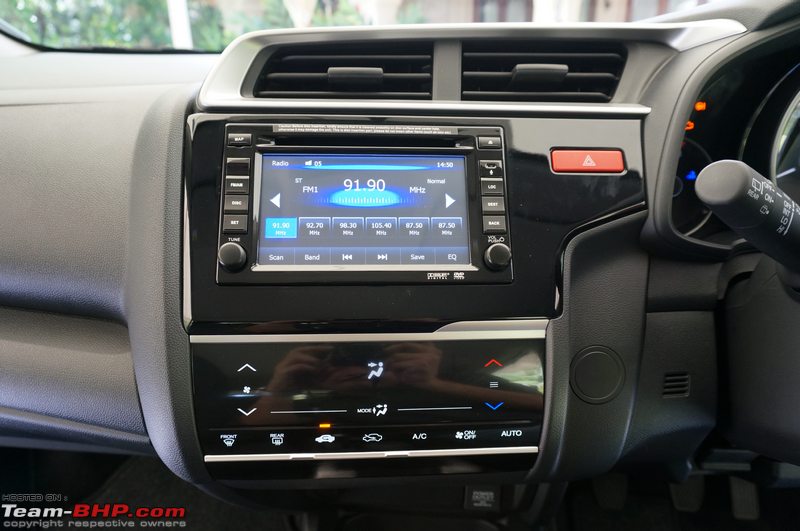 Satellite navigation is fairly basic. We ended up using our smartphones for navigation instead:  Reversing camera has a single viewing mode (V variant offers 3). Display quality suffers under the bright sun:  Gets a remote control:  Feather-touch climate control looks Łber cool. Easy to use too. A light tap is all that's required. Different controls are well spaced out, and the system responds with a confirmation beep for each input. Party trick: Swipe to max out / minimise blower and temperature settings. Downside? You need to take your eyes off the road to change any setting:  Center console has 5 storage slots, as well as 2 cup-holders. Unfortunately, this is at the expense of an armrest, which is found in the international Jazz. The driver's armrest is sorely missed, especially on the automatic variant: 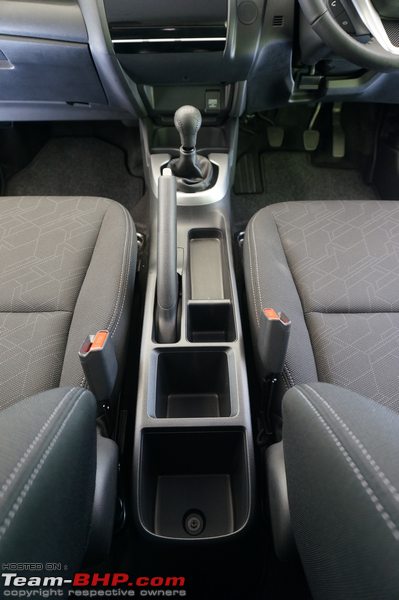 Two cup-holders ahead of the gear knob, and a rectangular storage spot that can easily hold a 5.1" smartphone:  Unlike the old Jazz, the new model doesn't get height-adjustable seatbelts:  Fat A-Pillars create blind spots around corners and ghat sections. The quarter glass provides an airy feel to the cabin though: 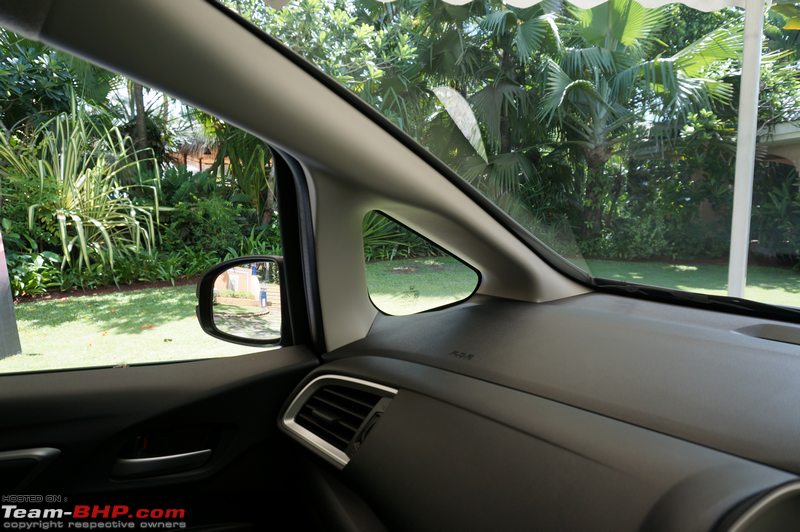 The outgoing Jazz had twin-glove boxes, a useful crevice in between and an additional cup-holder in front of the passenger's A/C vent. All missing on the new Jazz:  The glovebox is medium-sized. Seen here is a 5.2" Moto X for scale. Ugly USB / iPod / AUX cables dangling loose:  Classy matt silver surround (not there in the City):  Front map lights are the push-to-activate kind. This is the VX variant; the V variant has a mic here (pictured later): 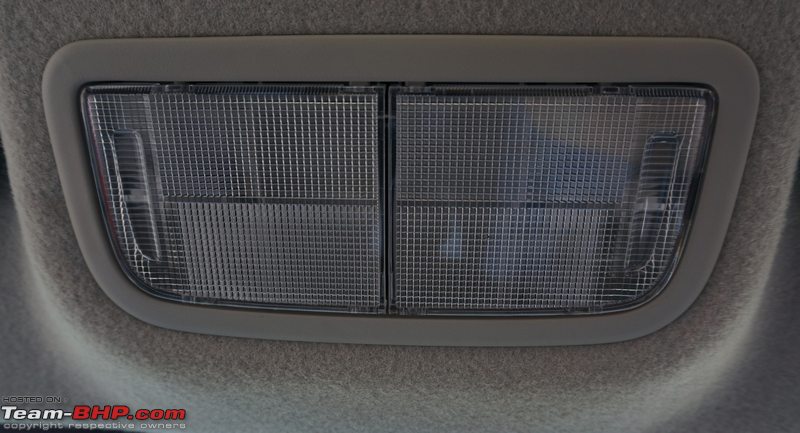 Only the passenger gets a vanity mirror. Older Jazz had one for the driver as well:  Foldable grab handles have a nice & soft damping action. Here's looking at you, VW Polo:  Last edited by suhaas307 : 11th July 2015 at 12:17. |
| |  (78)
Thanks (78)
Thanks
|
| The following 78 BHPians Thank suhaas307 for this useful post: | .anshuman, Added_flavor, AdityaDeane, aeroamit, Aficionados, arif_iq, AutoIndian, carrazy, Chethan B G, CrAzY dRiVeR, deetjohn, dhanushs, dkaile, Dr.AD, ecosport rules, eyesice, Ferruccio, fusionbang, Gannu_1, GeeTee TSI, Grace, GTO, hemanth.anand, IronH4WK, itsashishsharma, jeetaman, JoseVijay, kutts, laferrari, lemedico, libranof1987, MDED, Mevtec, mh09ad5578, mi2n, mrbaddy, MSAneesh, Nohonking, paragsachania, parsh, phynix123, pratika, RavenAvi, razor4077, recshenoy, roby.thomas, rshanker, RSR, S.MJet, S2!!!, samabhi, SchumiFan, scopriobharath, Sheel, Simhi, sqs103, swiftnfurious, Technocrat, The Observer, The Rationalist, theexperthand, themonster, theredliner, Tushar, uday.ere, vaasu, Varun_HexaGuy, vb-saan, VeluM, vibbs, Vid6639, Vigkey, VijayAnand1, vikred, VinNam, Vivek Jayan, Wildy, yosbert |
| | #4 |
| Team-BHP Support  Join Date: Aug 2009 Location: Bangalore
Posts: 9,157
Thanked: 14,549 Times
| Interior - Rear While getting in, the first thing you'll notice about the new Jazz is the larger rear door. This makes ingress / egress a breeze! The old car had a smaller door in comparison. The pensioners are going to love this  ! !They're going to love it even more when they sink their behinds onto the rear bench. Suffice to say, it is a huge improvement over the old Jazz (which was already a spacious car). In spite of its flexibility, the rear seat is properly contoured for support. The seat squab is longer too, thereby making it more supportive and comfortable. Space has improved considerably. There is a lot more knee room for rear passengers (115 mm increase over the old car), while elbow room remains a non issue. Headroom is adequate as well. I had a good 3 inches of space between my knee and the driver's seat (adjusted for my 6'1" driving position). 6-footer Vid6639 has a relaxed driving position and still, two Vid6639s can sit one behind the other. The cabin is brilliantly packaged and this is easily the most spacious hatchback in India today. The good news doesn't stop there. To elevate comfort levels, the seatback reclines by about 3 inches! This is a segment first. The old car's seatback was too upright and thus, Honda has corrected it in the 3rd-gen. If backseat comfort is your priority, the Jazz VX should be your pick. The cabin has decent width and the floor hump isn't too tall either. A 5th occupant can fit in, although he'll have to contend with sitting perched up (center area of the rear seat is raised). Things aren't as bright with the Jazz' lower variants though. Those who opt for lesser trim levels will have to make do without the flexible "magic seats". Now, we'd naturally assume that non-flexible seats should offer you even more support, right? Not in the Jazz. Under-thigh support is seriously lacking in variants below the VX...this is disappointing as a majority of sales are usually from mid-variants. Not only is the rear bench less contoured, it has been set too low for comfort. This, coupled with the raised floor, makes a noticeable difference in comfort levels between the Jazz top-end and other variants. While the raised floor (result of the fuel-tank being placed under the front seats) serves as a footrest in the VX, it's a bane in the lower variants. The neck restraints on the VX are adjustable, but they're fixed & useless on the V. Unlike the Elite i20, the Jazz doesn't come equipped with rear A/C vents. The old Jazz had floor-level vents that were routed under the front seats and now, even that's missing on the 2015 Jazz. In terms of storage at the back, the door pockets can either hold a 500 ml bottle or knick knacks (not both). You get useful seatback pockets on both front seats (VX variant only). The old Jazz had a secret compartment under the rear seat squab. Though the rear seats of the new Jazz offer some space below the squab, that secret compartment is gone! Like its predecessor, the new Jazz is equipped with what Honda calls "magic seats". This time around, they are exclusive to the top VX variant only (earlier Jazz offered them on all variants). What's interesting about this is the rear seat's flexibility. There are several permutations and combinations you can tap, based on the situation. Folding the seats is a one person job and requires minimal effort. No sweat at all. The rear seats can split in a 60:40 ratio. If both are folded down, they form a completely flat floor. Further, the seat base can tumble / flip up, as it did before. You can even turn your Jazz into a business class cabin, by removing the front passenger seat's headrest, pushing the seat forward and folding the seatback parallel to the floor (refer to images below). A chauffeur-driven owner can fully stretch & relax in this mode. The boot is down on space by around 30 liters vis-a-vis the old car, yet it remains the biggest amongst hatchbacks (capacity = 354 liters). Shifting luggage in and out is easier than it is with most cars. The low loading lip & practical layout help matters here. It took a while for our holiday suitcases to be arranged in the 405 liter boot of my Civic, but the same luggage took two minutes to stuff into my (2nd-gen) Jazz. Fold the magic seats flat and you get 881 liters of cargo space. With lower variants, the flexibility is limited. The seats neither split 60:40 and nor do they fold completely flat. While Honda has added a parcel tray as standard equipment this time around, they've deleted the bag hooks & small storage compartments that were there earlier in the boot area. What's also missing are strings that connect the parcel tray to the hatch. Seriously now! Rear doors are longer than they were in the previous Jazz, allowing for easier ingress / egress. Moreover, they open at an angle of nearly 90 degrees. Door pocket is good for a 500 ml bottle or knick knacks (not both):  Class-leading space at the back. The old Jazz was already one of the roomiest hatchbacks in India. Honda claims that the new Jazz gets a whopping 115 mm of additional legroom. As a result, rear space is better than many higher priced sedans!  The seatback of the old Jazz was set upright. Looks like Honda realized this: The Jazz is now the only hatchback to get reclining rear seats. Other cars that have this feature include the EcoSport and Corolla Altis. The seats are wide enough for three passengers, but the section in the middle is raised. 5th occupant sits perched up. This could be uncomfortable for him, especially on long drives:  This pic, and the one above, shows the difference in recline angles. Doesn't look like much, but it does make a difference:  If you keep the seatback in the most upright position, there's a gap of about one inch from the parcel tray. Easy for stuff to fall into the boot if you're not careful. This gap is also there in the EcoSport:  Rear headrests are adjustable on the VX only (lower variants get useless non-adjustable ones):  Floor is almost flat, and the floor hump is very small. The floor slopes up towards the front seats, as the fuel tank is located below (old Jazz also had it under the front passenger's seat):  Two seatback pockets for storage. No rear air-con vents like the Elite i20. Not even the foot level vents that the old Jazz had:  Useful cabin light placed between the front & rear seats. Strange how some manufacturers miss out on this:  Rear passengers get 3-point seatbelts on either side, and a lap belt for the passenger in the middle. Also note how the quarter glass is smaller than the one of the old Jazz. Still, overall glass area is generous and there's enough light at the back:  Team-BHP's super model - Vid6639 - is back! Here's his 6 feet frame with the front seat pushed all the way forward...  ...and with the front seat set up for a 6 footer. Two tall dudes can easily sit one behind the other in the Jazz: 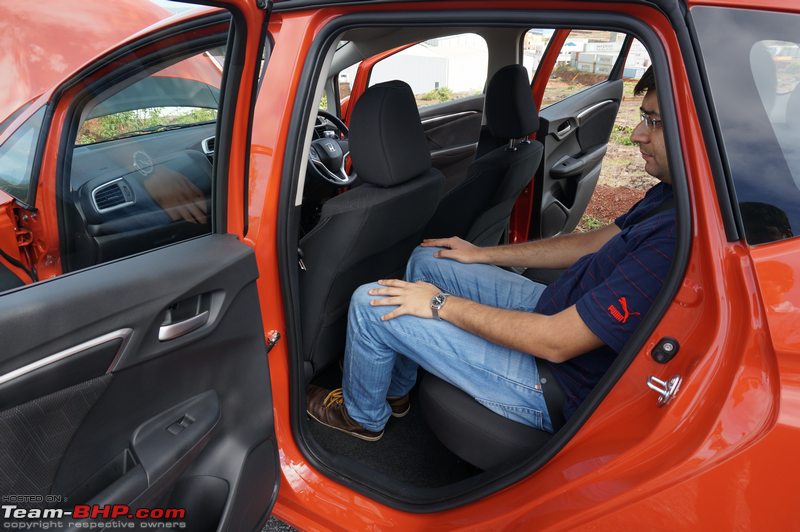 With the front seat all the way behind. Vid6639 still fits in without complaint:  This is what Honda calls "refresh mode". Remove the headrest from the front seat, slide the seat all the way forward, and then recline the backrest till it's flat. Voila! You now have first-class seats in your Jazz. Good for a nap as Vid demonstrates. Be sure to buckle up when seated like this:  The magic seats (VX only) offer various permutations & combinations. Flexibility is fantastic, and you can literally move house with an assortment of big objects easily fitting into the Jazz. Seen below is the "tall mode". Simply lift the seat base up and push the metal leg down to lock it in place. To unlock it and bring it back down, just pull the metal leg back up. You can use this mode to transport items like a study desk or plants: 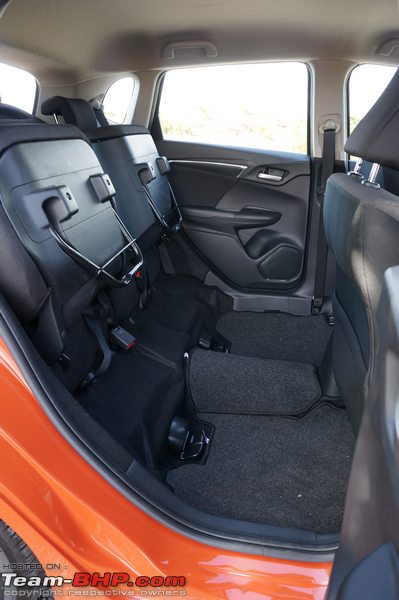 At 354 liters, boot space is the largest among hatchbacks. Lesser than the old Jazz, but still more than a compact sedan like the Maruti Dzire. Low & wide mouth means it's convenient to load luggage in here:  Neat seat latches sit flush. One man job to access the various combinations offered by the magic seats:  Check out this small pocket behind the right seat, to help lifting it back up:  The seats split in a 60:40 ratio:  Need to move long objects like a surfboard? No problem, here's the "long mode", wherein the front seat can be reclined all the way down to accommodate such items:  Fold the rear seats down and you get a completely flat floor, which opens up 881 liters of cargo space!  Rear parcel tray is fixed and doesn't move up when you lift the hatch. It has two deep grooves to park the odd items: 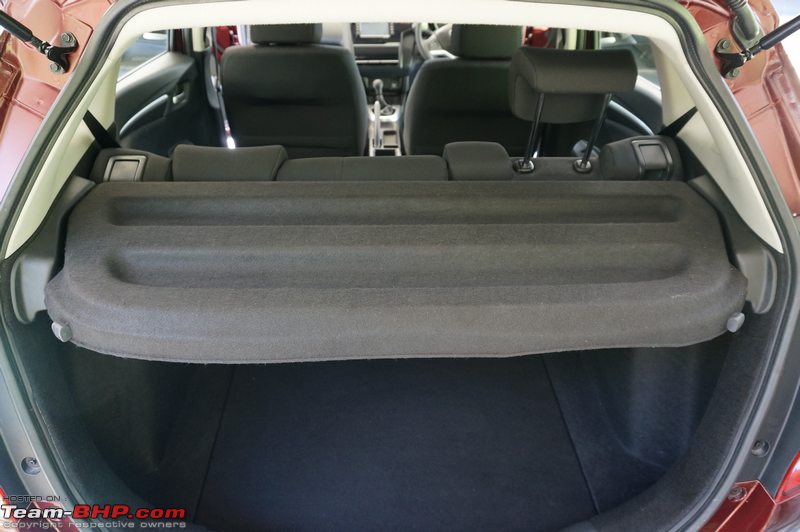 Boot lamp? Check:  Groove to help with closing the hatch:  Tools are neatly placed in the boot (not loose like in the City). Spare tyre wraps around a 14" steel wheel (tyre size = 175/70 R14). Surprisingly, while our Jazz rode on Michelins, the spare is an MRF. Maybe it got shuffled between the many media cars:  Last edited by GTO : 8th July 2015 at 12:29. |
| |  (58)
Thanks (58)
Thanks
|
| The following 58 BHPians Thank suhaas307 for this useful post: | .anshuman, Added_flavor, AdityaDeane, aeroamit, arif_iq, Arwin07, AutoIndian, carrazy, deetjohn, dkaile, ecosport rules, fusionbang, GTO, harsh79, hemanth.anand, IronH4WK, itsashishsharma, jeetaman, lemedico, libranof1987, MDED, mh09ad5578, mrbaddy, MSAneesh, Nohonking, parsh, phynix123, rajesh1868, rav11stars, RavenAvi, rednikhil, rshanker, RSR, S2!!!, samabhi, SchumiFan, scopriobharath, Sheel, Simhi, swiftnfurious, Technocrat, The Observer, The Rationalist, theexperthand, themonster, theredliner, turbospooler, Tushar, uday.ere, Varun_HexaGuy, vb-saan, VeluM, vibbs, Vid6639, Vigkey, Whiplash7, Wildy, yosbert |
| | #5 |
| Team-BHP Support  Join Date: Aug 2009 Location: Bangalore
Posts: 9,157
Thanked: 14,549 Times
| The V Variant (one level lower than the top-end VX) The lower V variant with black & beige interiors. This is the Jazz CVT:  In this image, you can tell how the Jazz' center console tilts toward the driver:  Beige seats. The all-black VX uses better quality fabric:  Padded beige insert on the doorpad:  Pedals of the AT variant. Dead pedal is wider, and more useful than the MT's: 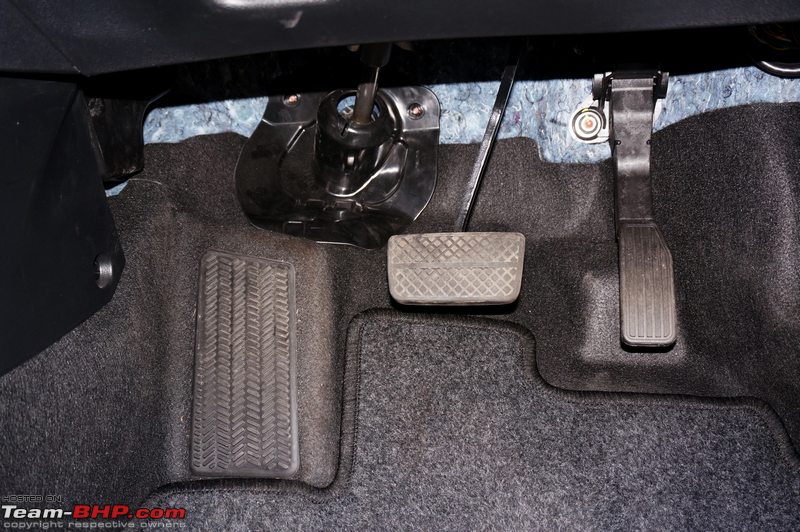 The head-unit is different here. Looks better integrated than the VX's. Further, the button quality makes it feel like a proper OEM system:  Reversing camera gets three viewing modes (top, normal or wide):  Lower V variant gets better AUX & USB slots on the center console (unlike the dangling glovebox wires of the VX):  The VX has its Bluetooth mic on the head-unit, whereas the V variant gets the mic neatly placed between the map lights:  Beige & black doorpad on the V variant:  Lesser variants don't get 'magic seats'. The rear seat feels like it sits lower. We didn't find it to be as supportive as the VX's seat. On the other hand, because the seat is flatter, the middle passenger will be more comfortable here. The headrests are fixed. They're too short for taller occupants:  No seatback pockets. What's worse is that the extra padding from the seatback pocket is missing. If you're tall, this results in your knees rubbing against the metal frame of the front seat:  The seats of the lower variants don't recline, and are set to a more upright position. This brings a 1 inch gap between the seatback & parcel shelf. Gap ought to have been covered: 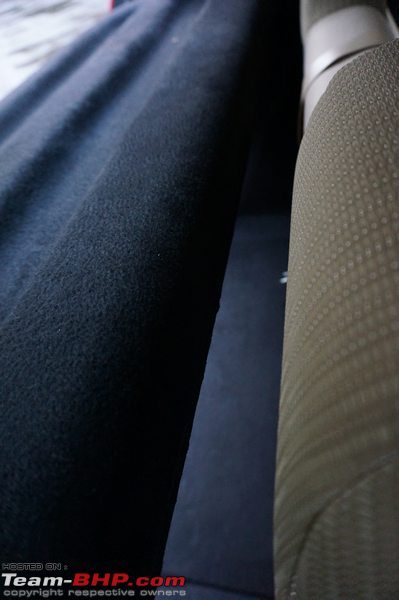 Single piece seat (no 60:40 split). See how this car doesn't get the seat latches; you get pull-type stalks made of a cheaper plastic instead:  Rear seat folds down, but not flat. Why not? Because, in the VX, the magic seat's base actually slides a little lower to allow flat folding:  Last edited by GTO : 8th July 2015 at 12:31. |
| |  (49)
Thanks (49)
Thanks
|
| The following 49 BHPians Thank suhaas307 for this useful post: | AdityaDeane, aeroamit, AutoIndian, carrazy, Chethan B G, deetjohn, dhanushs, fusionbang, Gannu_1, GTO, harsh79, hemanth.anand, IcarusMan, IronH4WK, jeetaman, lemedico, libranof1987, mandywanders, mh09ad5578, mrbaddy, Nohonking, parsh, phynix123, RavenAvi, rshanker, RSR, S.MJet, S2!!!, samabhi, SchumiFan, scopriobharath, Sheel, shipnil, Simhi, swiftnfurious, Technocrat, theexperthand, theredliner, Turbo_asd, Tushar, uday.ere, Varun_HexaGuy, VeluM, vibbs, Vid6639, Vigkey, VinNam, Wildy, yosbert |
| | #6 |
| Team-BHP Support  Join Date: Aug 2009 Location: Bangalore
Posts: 9,157
Thanked: 14,549 Times
| Driving the 1.5L Diesel MT 1.5L i-DTEC sure is a tight fit in the Jazz' compact engine bay:  Diesel's 6-speed gear knob is the same as the City's:  The i-DTEC gets this plastic engine guard, but the Jazz petrol doesn't: 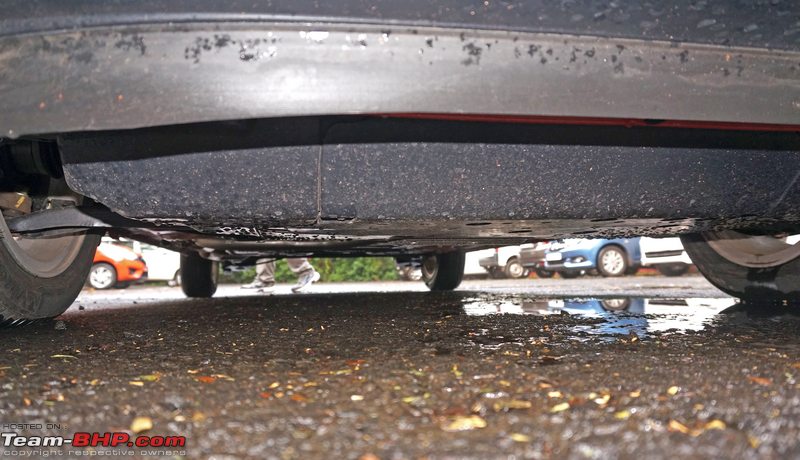 The 1.5L, 4-pot diesel and 6-speed manual gearbox are shared with the City. Good thing that it gets the 6-speed and not the 5-speed tranny of the Amaze & Mobilio. The diesel makes 99 BHP @ 3,600 rpm with 200 Nm of torque @ 1,750 rpm. Full technical details are available in this post. Crank the engine and you are greeted by a clatter that distinctively tells you it's a diesel. There is no mistaking it for anything else. In fact, the i-DTEC is loud even by diesel car standards. Driveability is what this engine brings to the plate. The diesel is responsive from idle rpms itself. Torque and power delivery are so linear that you feel at home right away, even if you've been driving naturally aspirated 4-cylinder petrols for a while. The gradual power and torque delivery, coupled with evenly spaced gear ratios, make the Jazz immensely tractable. Light throttle inputs are all you need to putter about in town. Since there is none of that 'kick' coming in when the turbo spools up, it's very easy to drive within city limits. Throttle response is good when you step on it, in high gears too, due to the lack of turbo lag. The engine tune is practical and makes for few gear changes in urban India. Straight line acceleration is peppy. There is more than enough torque to get you going, and enough power to sustain it. Overtaking is fuss-free; the lack of lag helps here as well. That said, its tune really focuses on the low to mid rpm ranges. Open road performance is competent, but the Jazz 1.5 isn't as quick as the Polo GT TDI's 1.5L diesel (103 BHP / 250 Nm). The VW remains the choice of enthusiasts. This engine isn't high-rpm friendly either. The i-DTEC revvs to a max of ~4,450 rpm only, but it doesn't like going over 4,000. The engine doesn't sound or feel happy near the redline. It's best to work the torque and shift up earlier. The Jazz diesel can cruise at triple digit speeds all day long. For the record, the engine isn't electronically limited to 140 kph, as it is in the Amaze. You'll easily maintain the pace with fast traffic on the right lane of the expressway. Over long distance driving, the 6th gear ratio makes it a relaxed cruiser (related thread). Climbing up steep inclines & ghat sections is an effortless exercise too. The Jazz diesel has an ARAI rating of 27.3 kmpl. The i-DTEC delivers high fuel economy and will keep its owners happy in this area. Honda claims that the gearing isn't the same as the City's. The Jazz has taller gearing to enhance fuel economy. They could get away with this due to the Jazz' lower kerb weight. The small, short throw 6-speed gearbox is nice to use. It does have a notchy side though (Vid6639 didn't like the way it engaged 2nd from time to time). The clutch isn't too light nor too heavy. It's par for the course. An area where the Jazz disappoints is NVH. The insulation levels are similar to the City and not the Amaze. Still, the engine is very audible inside the cabin, even at an urban revv range of 1,800 - 2,000 rpm. What makes it worse is the crude, unpleasant engine note. On the move, the diesel motor always makes its presence felt. A Honda techie stated that aluminium diesels are inherently noisier. Another major disadvantage of the Jazz diesel is the significant amount of engine & drivetrain movement felt on the pedals. These vibes are felt not only on the clutch, but even on the accelerator. It's directly proportional to engine rpm. The experience takes away from the refinement you expect in a premium hatchback. Of course, vibrations aren't present anywhere else and passengers won't be complaining at all. That said, the Elite i20's smooth & refined diesel is in a different league altogether. Driving the 1.2L Petrol MT Both - the diesel & petrol - have an insulation sheet under the bonnet. The diesel needs it! Surprising that the Jazz petrol gets one as the City petrol didn't (link to image):  Familiar 1.2L i-VTEC motor:   Petrol variants get a 5-speed manual:  Compared to the diesel, there's a lot more empty space in this engine bay. The Jazz begs for the 1.5L i-VTEC from the City:  The petrol gets no underbody protection. You can see the tip of my shoe here:  Oil sump is dangerously exposed in the petrol. An easy target on bad roads. One flying stone and you're in for trouble:  Apart from a few tweaks, this 1.2L, 4-cylinder i-VTEC mill is the same one that did duty in the 2nd-gen Jazz (and currently powers the Brio & Amaze). The engine produces 89 BHP @ 6,000 rpm and 110 Nm of torque @ 4,800 rpm. That's 2 BHP & 1 Nm of torque more than in the Amaze. Honda could've easily offered the City's fantastic 1.5L i-VTEC engine in the Jazz (it's already started exporting the same). However, marketing considerations & lower excise duties made Honda choose the 1.2L. Well, we can only hope that the 1.5L is offered in the future, at least in a limited 'performance' edition. As things stand today, VW's delicious 1.2L TSI is the benchmark petrol engine among hatchbacks. Start the Jazz petrol and the experience is the opposite of the diesel. The motor is super silent, staying that way at low revvs. Even in performance & driving characteristics, the petrol & diesel motors are diametric opposites of each other. Where the i-DTEC offers superb driveability, the 1.2L suffers from a weak bottom end. It feels distinctly weaker than in the Brio & Amaze. That's probably down to the tall gearing, the Jazz' heftier kerb weight & economy-focussed tuning. Torque at low rpms is poor and the throttle feels very dull in certain situations. You'll have to seriously flog it if you want to zip through traffic. Giving it stick surely won't help the fuel economy though! Where the diesel could be driven like an automatic, the 1.2L petrol requires frequent downshifts in the city. Though both are powered by the same engine, the li'l Brio feels much sprightlier and eager in the exact conditions that the Jazz feels lethargic. Remember how Civic owners unanimously complained about driveability in the city? You'll hear Jazz owners singing a similar tune. Climb up the revvs and you'll experience a mid-range that is acceptable (above 3,000 rpm). Here's where the engine note becomes audible. It's a likeable sound for enthusiasts, but not for the layman. Like all Honda petrols, the Jazz is eager to revv and climbs up happily to just under 7,000 rpm. That's a good thing because you'll need to revv the 1.2 to access its performance. The motor really gets alive past 4,000 rpm. Revv it hard with perfectly timed gearshifts and you'll get healthy acceleration times. But you have to make the engine work hard. It's not underpowered, yet performance simply isn't as effortless as the Polo GT TSI which flies at any rpm, any speed. Expressway capability is satisfactory (not outstanding). The Jazz will keep up with fast traffic in the right lane. When you want to overtake, you'll have to downshift...no two sides to that. On a single lane highway, Vid6639 had to wring the engine in 2nd or 3rd gear every time he wanted to overtake. The tall gearing is a trait of the old car that is unfortunately retained in the new one. Example: 2nd gear is big enough to cross 90 km/h. We've been told that the gear ratios are identical to the 2nd-gen Jazz. In terms of fuel economy, the petrol MT carries an ARAI rating of 18.7 kmpl. End of the day, you'll wish that Honda had provided the 1.5L petrol on the Jazz. The 1.2L's behaviour isn't befitting of a premium hatchback. Even the Swift petrol has a better power to weight ratio. The gearshift's action is light & slick. The gates are narrow, as is usually the case with Honda's gearboxes. The clutch is light enough. Driving the 1.2L Petrol CVT The 7-speed CVT's shifter is shared with the City:  Paddle shifters on the steering wheel. Pull the left one to downshift & right one to upshift:  Current gear indicator within the rpm gauge. When using the paddle shifters, it'll display which of the 7 'virtual' ratios you're driving in (D1 - D7). Sport mode changes that to S1 - S7:  The CVT paired with the 1.2L i-VTEC mill makes for a great urban commuter, and it's perfect for point A to point B driving. The convenience is unmatched. This gearbox & engine combination improves the petrol car's driveability to a great extent, and throttle response in city traffic is good. As is typical of CVTs, the gearshifts are seamless and the driving experience is butter smooth. Club that with the light steering and moving about in the city becomes effortless. Press the accelerator hard and, like most CVTs, the buzzy engine seems to revv pointlessly (rubber band effect). You can even hear the transmission inside the cabin when driving aggressively. Flooring the accelerator sees the engine revving to a max of 6,000 rpm in manual mode, before the CVT upshifts. It's just better to leave the gearbox in 'D' mode and drive in a relaxed manner. Nearly all CVTs prefer to be driven sedately and the Jazz is no different. It doesn't like being overworked. In fact, whenever you lift off the accelerator pedal, you'll notice its tendency to move up the gearing. By now, it's obvious that the Jazz CVT is more suited to the city than the highway. Honda has equipped the Jazz with paddle shifters, but don't let them fool you into thinking that this is a 'sporty' car. The CVT lets you access 7 pre-defined ratios with the paddles. Where the paddle shifters are useful is in preparing the Jazz for overtaking (before the move). You must also use the paddle shifters for engine braking while driving down a steep slope. The gearbox responds reasonably fast to the paddle shifters. I noticed that pulling the left paddle results in a strange 'forced' blip from time to time  . The paddle shifters can be used even in 'D' mode, although the gearbox goes back to full auto mode after a few seconds of not using the paddles. . The paddle shifters can be used even in 'D' mode, although the gearbox goes back to full auto mode after a few seconds of not using the paddles. Honda brags that the Jazz CVT carries an ARAI rating of 19 km/l. Because of the tall gearing that's possible with CVTs, they usually have a good ARAI rating. In your day to day driving style, don't expect FE that's anywhere nearly as impressive, given that the rubber-band effect is more pronounced in this small 1.2L engine (it wasn't with the City's 1.5L). On a related note, remember the City's ECON button (image link) that made the CVT run in 'fuel economy' mode? It's not there in the Jazz. Ride, Handling, Steering & Braking The new Jazz sits on a well tweaked suspension that is a massive improvement over the old car. Crashing into potholes is a thing of the past and now, it no longer feels under-damped at low speeds. Honda has managed to iron out the stiffness in the ride quality very nicely. The Jazz rides comfortably on Indian roads. You won't hear those annoying 'thuds' like in the old Jazz either! The 2015 car is fairly compliant over undulations too, transmitting very little back into the cabin. Ground clearance has increased marginally by 5 mm to 165 mm (Elite i20 = 170 mm). We didn't test the GC with a full load of passengers & luggage onboard and will leave the final verdict to our ownership reports. Must add that the new suspension should see it handle speed breakers better than the old car. The new Jazz doesn't appear to sag as easily anymore. Ride quality at higher speeds is competent as well. It manages to absorb most irregularities and doesn't feel over-sprung like the old car. The Jazz glides over the rough stuff without breaking into a sweat. Honda's objective was clearly to improve comfort levels and it has succeeded. The car feels fairly stable at 120 kph and isn't nervous on the highway. That said, it isn't rock solid like a Ford, Fiat or Volkswagen. The handling is neutral for the most part. Body roll is controlled, while grip levels are acceptable. It's no corner carving driving machine though. The suspension's behaviour is safe & predicable, but it's not a car whose handling will leave a grin on your face. The press cars wore 175/65 R15 Michelin XM1 rubber. It's puzzling why Honda chose an outdated tyre for such an important launch? The XM2 has been around since 2012! We weren't happy with their performance. I don't expect production cars to come wearing these XM1s. While on the topic, BHPians will find a 185 or 195 patch tyre to be more suitable for the Jazz. The steering of the diesel was a pleasant surprise. In spite of being light, it's direct and fuss-free. Sure, it's no hydraulic unit, but it's a decent EPS that has been calibrated well. On the other hand, the petrol car's steering needs retuning. It's simply too light. While that's welcome in the city, it's not on the highway. It did weigh up as the speedometer climbed, albeit not enough. The petrol's steering just didn't inspire confidence at high speed. Turning radius = 5.1 meters. That's marginally shorter than the Elite i20's 5.2 meters, but it doesn't offer the same convenience or chuckability of cars like the Swift (4.8 m). The Jazz has the standard front disc & rear drum braking hardware. The brakes perform as expected. The car stops in a straight line sans drama when braking from high speeds. You'll just take some time getting used to their over-servoed feel & sharp bite. Honda has ingeniously routed the exhaust from the right side. The fuel tank is on the left side. Honda claims this is to improve ground clearance and give it a flat floor in the center:  The exhaust doesn't protrude out as much and it does appear to aid ground clearance. We didn't scrape at all...even after trying hard on some bumps:  A peek at the other side where the fuel tank is placed:  Last edited by GTO : 8th July 2015 at 12:33. |
| |  (68)
Thanks (68)
Thanks
|
| The following 68 BHPians Thank suhaas307 for this useful post: | .anshuman, aeroamit, Aficionados, ampere, AutoIndian, Blue Thunder, carrazy, Chethan B G, dean5545, deetjohn, dhanushs, dkaile, drhoneycake, ecosport rules, fiat_tarun, Gannu_1, gschandra, GTO, harsh79, hemanth.anand, Insearch, IronH4WK, itsashishsharma, jeetaman, lemedico, libranof1987, mandywanders, MDED, mh09ad5578, motorpsycho, MSAneesh, nkishore_007, Nohonking, parsh, RavenAvi, Reinhard, Researcher, rshanker, RSR, S.MJet, S2!!!, samabhi, SchumiFan, sdp1975, Sheel, shipnil, Simhi, StepUP!, swiftnfurious, Technocrat, The Observer, theexperthand, themonster, theredliner, tsk1979, Turbo_asd, Tushar, uday.ere, Varun_HexaGuy, vb-saan, VeluM, vibbs, Vid6639, Vigkey, VijayAnand1, Wildy, yosbert, zavegur |
| | #7 |
| Team-BHP Support  Join Date: Aug 2009 Location: Bangalore
Posts: 9,157
Thanked: 14,549 Times
| Other Points: • In preparation of the launch, Honda shipped 2,336 cars to its dealers in June. • Except for 46 liters more boot space & better performance from the 1.2L petrol, the Amaze has little to offer over the Jazz. Makes its case very difficult. The Jazz is superior to the Amaze in nearly every way. The Elite i20 outsells the Xcent by a fair margin - will we see the same in Honda showrooms? • The 2nd-gen Jazz had 3 variants and merely 1 engine & transmission combo. The 2015 Jazz not only gets 5 trim levels, but also 3 engine and gearbox combinations. • In keeping with the cost cutting employed by most manufacturers today, Honda has removed several little bits & bobs from the car (listed in my review). On the flip side, there are many things they've added, like two cabin lights (just one in the older car) for example. • I reiterate that Honda has missed a trick by not selling the Jazz 1.5L i-VTEC here. Even Mr. cost cutting - the Mobilio - gets the 1.5L petrol. Customers are slowly warming up to powerful, expensive & loaded hatchbacks (case in point = Polo GTs). After the pricing debacle of the last Jazz, Honda must've wanted to control the initial sticker shock (1.5L top variant would easily be more expensive by 75k at least). Plus, the 1.5L is one more differentiator in favour of the City. Some people have already started viewing the Jazz as a 'smaller City' and they're not off the mark. • The same 1.2L petrol is mated to a 5-speed torque converter AT in the Brio & Amaze. The same CVT is mated to a 1.5L petrol in the City. Now, we have the Jazz 1.2L CVT. Honda has truly mixed & matched things up here. • The air-con compressor cuts off when you mash the throttle. I've observed this in my old Jazz as well. • Honda claims that cabin volume has increased by 139 liters (over the old car). It's shorter than the Elite i20, yet offers a larger cabin and bigger boot. The Jazz nameplate is synonymous with brilliant interior packaging. • As with the old car, the fuel tank is positioned below the front seats. Helps packaging. The exhaust has also been routed differently in the new Jazz. • ABS is standard on all diesel & CVT Automatic variants. • No parking sensors on any variant! V & VX only get the reversing camera. • Honda might have sold 55 lakh units of the Jazz worldwide, but that doesn't make a difference to the Indian customer. No value = no sale. Honda learned this the hard way with the 2nd-gen Jazz' pricing debacle & resultant failure. • Lane change indicators blink thrice on a light tap of the indicator stalk. • The front suspension has increased caster trail, and a new lightweight subframe. • Until you open the doors, the power windows can be operated for some time after you remove the key from the ignition. A practical feature that allows you to roll up any windows that might have been left open. • The Jazz is equipped with 'pedestrian injury mitigation'. What that basically means is that various parts of the front end are designed to absorb energy in an impact with a pedestrian, thereby reducing his chances of injury. Further, Honda says that the front seats are equipped with special 'impact mitigating headrests' that reduce the possibility of neck injury in rear impacts of low speed. • Fuel tank capacity = 40 liters. That's 5 liters lesser than the Elite i20. • The difference between the Jazz' urban and Amaze's mass market positioning are evident from the ads itself. Also, you'll remember that the Amaze's ads were in Hindi. Jazz communications so far have been in English only: Disclaimer: Honda invited Team-BHP for the Jazz test-drive. They covered all the travel expenses for this driving event. Last edited by GTO : 16th October 2015 at 11:09. Reason: Diesel kerb weight now available |
| |  (49)
Thanks (49)
Thanks
|
| The following 49 BHPians Thank suhaas307 for this useful post: | .anshuman, aeroamit, arif_iq, AutoIndian, baz_303, carrazy, dhanushs, drhoneycake, fusionbang, Gannu_1, GTO, harsh79, hemanth.anand, IronH4WK, itsashishsharma, jeetaman, mandywanders, MDED, mh09ad5578, neil.jericho, Nohonking, RavenAvi, rshanker, RSR, Ryuu, S2!!!, samabhi, sbalagru6, SchumiFan, Sheel, shipnil, Simhi, Strider24, swiftnfurious, Technocrat, The Observer, theexperthand, themonster, theredliner, treadmark, Turbo_asd, Varun_HexaGuy, vb-saan, VeluM, vibbs, Vigkey, vsrivatsa, Wildy, yosbert |
| | #8 |
| Team-BHP Support  Join Date: Aug 2009 Location: Bangalore
Posts: 9,157
Thanked: 14,549 Times
| The Smaller yet Significant Things: Key is like that of the City's V variant (and not the one used for the Brio & Amaze):  Ugh, no wheel well cladding at the rear. Front wells get partial cladding:  A lower fuel tank & shorter suspension trailing arms help increase cabin space:  Height-adjustable steering gets a thin rubber shroud. It hides the ugly bits when the steering is set at a lower position:  Rear window doesn't roll all the way down:  Interesting rubber beading around the door locking mechanism:  Open the fuel-lid and you'll only see primer inside (not paint):  Showing you the underside of the VX's spoiler where the washer nozzle sits:  A closer look at the many cubby areas around the handbrake:  The max that the VX's rear neck restraints extend out to. They'll easily support tall occupants (V's fixed headrests won't):  Some under-seat storage space akin to the old car. Can be useful for oddities like an umbrella:  'Sport' mode with 1st gear manually engaged showing on the CVT's revv counter:  Side by side in two different shades. Honda has chosen the colours in a peculiar manner. That nice metallic blue isn't available, and neither is black  !! Check out all 7 colour options here: !! Check out all 7 colour options here: Last edited by GTO : 15th July 2015 at 08:27. |
| |  (62)
Thanks (62)
Thanks
|
| The following 62 BHPians Thank suhaas307 for this useful post: | abhi29, aeroamit, Aficionados, arif_iq, Arindam_Nayek, AutoIndian, bansal.sushant, Bhodrolok, carrazy, Chethan B G, coolmel, dhanushs, drhoneycake, ecosport rules, GTO, harsh.m06, harsh79, IronH4WK, itsashishsharma, jeetaman, Keynote, KPS, lemedico, mandywanders, MDED, mh09ad5578, Nohonking, parsh, RavenAvi, recshenoy, rshanker, RSR, rutvij, S2!!!, samabhi, sameer sultan, SchumiFan, scopriobharath, Sheel, shobhit.shri, SunilM, sups, swiftnfurious, Technocrat, The Observer, theexperthand, themonster, theredliner, Turbo_asd, Tushar, uday.ere, valapad, Varun_HexaGuy, vb-saan, VeluM, vibbs, Vid6639, Vigkey, Viju, Wildy, yosbert, Zubin21 |
| | #9 |
| Team-BHP Support  Join Date: Aug 2009 Location: Bangalore
Posts: 9,157
Thanked: 14,549 Times
| What you'll like: • All-rounded package in a sharp design. Improved over the 1st-gen i20 in nearly every way • Spacious interiors with outstanding quality, fit and finish. Practical 285 liter boot too • 1.4L diesel has excellent driveability, refinement, performance & fuel economy. 6-speed gearbox is smooth • Mature suspension offers a comfortable ride and neutral handling characteristics • Hyundai's fuss-free ownership experience & excellent after-sales-service • Loaded with features & gizmos (16" rims, keyless entry & go, 8-speaker stereo, rake & reach steering, rear air-con, reversing cam, cooled glovebox and lots more) What you won't: • Missing equipment vis-a-vis old i20: Rear disc brakes, side & curtain airbags, sunroof, auto-wipers & DRLs • 1.2L petrol is nowhere as impressive as the diesel. Mediocre highway performance for a premium hatchback • Anyone over 5'11" will find rear headroom to be insufficient. Sloping roof eats into cabin height at the back • Dynamics & steering aren't to an enthusiast's tastes. Swift, Polo etc. are more fun to drive • On-road price difference between the petrol & diesel is ~1.3 lakhs. That's higher than the competition • Rear wiper only on the top Asta trim! No fuel-efficiency indicator, auto-locking doors or height-adjustable seatbelts on any variant What you’ll like: • Snazzy styling packs appeal. Interiors are well-designed too • Competent engine range. Very refined motors • Balanced ride and handling. Superbly tuned suspension • Terrific fuel efficiency, especially from the diesel • Effortless to drive in the city; lots of fun on the highway • Maruti’s excellent after-sales service & wide dealer network What you won’t: • Small, impractical boot. Luggage capacity is severely restricted • Mediocre brakes (LXi / LDi & VXi / VDi). Inadequate for emergency braking conditions • Looks nearly identical to the outgoing generation car • Rear seat space, though improved, still isn't "spacious" • Pricey ZXi / ZDi variants. Also, ABS is only offered on the VDi and ZXi / ZDi variants What you'll like: • A well-built solid European hatchback • 1.5L diesel & 1.2L TSI petrol engines are very competent • Clean and contemporary styling. Absolutely no quirkiness • Mature suspension offers a balanced ride & handling package • Dual airbags even in the base variants! • Accommodating 280 liter boot What you won't: • Base 3-cylinder 1.2L petrol engine is unimpressive • Mediocre rear bench legroom and a large floor hump • Missing essentials (driver armrest of the Vento, 60:40 splitting rear seat, dead pedal, seatback pockets) • VW's sub-par dealership & service experiences What you'll like: • Build quality, fit and finish are on par with competitors. Tata has made significant improvements here • Spacious well-designed interiors. A rare hatchback that can seat 5 adults without a fuss • Competent 1.2L turbo-petrol & 1.3L diesel. Both offer good driveability • Balanced suspension offers safe & neutral handling. Nice EPS too • Light controls & agreeable ergonomics. Drives like no Tata hatchback has before • Superb 8-speaker Harman Kardon entertainment system with navigation & video playback • Features: 3-driving modes (Eco, Sport, City), projector headlamps, 5" touchscreen, voice commands etc. What you won't: • Neither engine offers strong outright performance. Both are commuter motors, nothing else • Impractical 210 liter boot is among the smallest from this segment • Pricing of some variants is too close to the Zest (Bolt XT vs Zest XT diesel = merely 31k) • Ride quality is firmer than the Zest. Noise insulation not as tight as its sibling either • AMT (automatic gearbox) & higher-tune 89 BHP diesel not on offer. Might follow later • Poor in-cabin storage & missing niceties (Zest's DRLs & parking sensors, dead pedal, height adjustable seatbelts) • Concerns over long-term reliability. Also, Tata's sub-par after-sales service is far from that of Maruti & Hyundai What you'll like: • A neutral family hatchback with the "T" badge • Spacious interiors can easily carry 5 adults • Super light controls, especially steering & short-throw clutch. Effortless to drive within the city • Well-tuned suspension. Safe handling and flat ride • Safety package (Airbags, ABS & EBD) optional on middle variant too • Toyota’s fuss-free ownership experience & excellent after-sales What you won't: • 1.2L petrol lacks bottom end. Diesel has merely 67 BHP on tap • Cost-cutting glaringly obvious in many areas • Economy-grade interior quality & unconventional dashboard • Missing equipment (climate control, height adjustable driver's seat etc.) • Poor insulation. Engine, suspension & road noise are prominent What you'll like: • Stunning design & styling • Solid build quality • Fuel efficient diesel • Mature & superb ride quality • Outstanding high speed dynamics. A benchmark amongst hatches • Perfectly calibrated & weighted power steering. Deserves a mention here • 5 star safety, ABS & airbags What you won't: • Rear bench space. Cosy interiors by big hatch standards • Interior fit, finish and quality are strictly average • Low FE of the petrol • Lack of outright performance (diesel). No high powered engine (a la Palio 1.6 100 BHP) • Engine noise at speed (petrol and diesel both) • Service network not a match to say, Maruti or Hyundai What you’ll like: • A well-rounded family hatchback • Superbly tuned 1.3L diesel powerplant. Short-throw gearbox is a pleasure to use • Spacious interiors. Rear legroom betters some sedans • Excellent ride quality mated to neutral road manners • Ideal for city driving : High seating position with a light steering, clutch and gearshift What you won’t: • Dated & unappealing styling • Missing features (No climate control, MID, steering-mounted audio controls, seat height adjustment) • Sensitive steering at high speed. Needs a steady hand on the expressway • Some quirky interior bits : Push / pull type door locks, centrally-placed window switches etc. Last edited by GTO : 8th July 2015 at 17:33. |
| |  (66)
Thanks (66)
Thanks
|
| The following 66 BHPians Thank suhaas307 for this useful post: | Abhi_abarth, aeroamit, Aficionados, amitpunjani, ashpalio, carrazy, Chethan B G, dean5545, devilwearsprada, dhanushs, diyaneesh, drhoneycake, ecosport rules, FINTAIL, FordDodo, fusionbang, gabrielthomas, Gannu_1, girishglg, gostel, GTO, heavenlybull, hemanth.anand, IronH4WK, itsashishsharma, jeetaman, Keynote, lamborghini, Latheesh, lovecars21, mac187, MDED, MetalBuff, Mevtec, myavu, neil.jericho, paragsachania, parsh, quick_silver, Rajeevraj, RavenAvi, riturajsharma19, RSR, S2!!!, SchumiFan, scopriobharath, Sheel, Simhi, sourabhzen, Strider24, Technocrat, The Observer, The Rationalist, theexperthand, theredliner, Turbo_asd, Tushar, uday.ere, vb-saan, VeluM, vibbs, Vid6639, vishnurajanme, Wildy, zavegur, Zubin21 |
| | #10 |
| Team-BHP Support  | Re: Honda Jazz : Official Review Thread moved from the Assembly Line to Official Reviews. Thanks for sharing! Suhaas & Vid6639, take a bow! Suhaas' ownership with the older Jazz has brought immense value, while Vid's eye for detail is unmatched. Rating thread a fully-deserved 5 stars. |
| |  (17)
Thanks (17)
Thanks
|
| The following 17 BHPians Thank GTO for this useful post: | Aficionados, ashwin.terminat, carrazy, Ferruccio, Keynote, lovecars21, mandywanders, MDED, Mevtec, RavenAvi, RSR, suhaas307, Tushar, uday.ere, vibbs, Vid6639, Wildy |
| | #11 |
| Senior - BHPian Join Date: Feb 2010 Location: Bardez, Goa
Posts: 1,181
Thanked: 1,033 Times
| Re: Honda Jazz : Official Review So the first review out of 8 promised by GTO. Disappointed with the overall package but can't see any fault of Honda as they are once bitten twice shy atleast wrt pricing so had to balance their act like what i20 did with their Elite. Now what's the USP of the car, was it magic seats but that is reserved for top variant, Snob value, I think Elite i20 beats it hands down, driveability is not exceptional, premiumness which was compromised at the launch of City so what is it. The mention of Elite i20 at numerous places shows who is the real (and only) competitor of this car and as times have changed, Elite i20 seems to be far better prepared than Jazz. I thought that the Honda won't miss a trick by launching atleast 1.5L version as it gets the duty benefits too but they haven't. So here goes another USP. All I can say is I would be surprised if this car becomes a hit and at the same time I would not be surprised if the car becomes a hit (seeing the success of City vis-a-vis Verna). P.S. : Feels good to see another review in Goa, which I predicted.  Also if Jazz becomes a hit, it will be exceptional achievement considering the failures of relaunches/price cuts like Fusion, Jazz, A-Star, Zen, etc. IMO Honda has taken a gamble. Lets see how it turns out. Last edited by GTO : 16th July 2015 at 10:14. Reason: As requested |
| |  (1)
Thanks (1)
Thanks
|
| The following BHPian Thanks carwatcher for this useful post: | modisan |
| |
| | #12 |
| BHPian Join Date: Jan 2015 Location: Bangalore
Posts: 675
Thanked: 1,216 Times
| Re: Honda Jazz : Official Review I was keenly looking at the Jazz i-DTEC VX variant over i20 Asta for the more drive-able diesel (in spite of the unrefined nature of the engine) +Black interiors + AVN + Magic Seats. I am very doubtful if all these put together is worth ~50k ex-showroom which might become over 75k on-road. To be frank, i-VTEC manual pricing seems pretty OK to me. Not aggressive but par. Now, Hyundai gave a clue already that they were taking Jazz very seriously by their unofficial announcement to the press that they will equip the i20 with touchscreen AVN without much of a premium. Now, seeing the pricing, Hyundai will be rethinking if they actually want to do that. Pricing and the general reaction to it is not favorable to Jazz and is making i20 look very VFM. Why would they want to spoil it by increasing the prices adding a new feature when there is virtually no threat from the new competition. Last edited by GTO : 8th July 2015 at 16:48. Reason: Typo |
| |  (7)
Thanks (7)
Thanks
|
| The following 7 BHPians Thank Vigkey for this useful post: | AutoIndian, GTO, Keynote, RavenAvi, w0lf, Wildy, Yeldo |
| | #13 |
| Team-BHP Support  | Re: Honda Jazz : Official Review Brilliant review of what is a very thoughtfully engineered car. Those 'magic seats' add a lot of practicality to the cabin. Brilliant indeed. And the front end looks very similar to the City now, that people will associate it to the sedan. And I must say it doesn't seem overpriced this time around, although the prices are not too aggressive also IMO. I feel it has the potential to do around 2.5k - 3k cars per month! Being more into diesels motors, here's a quick comparison I made of the Jazz diesel prices. i20 being the direct premium hatch competition, Honda City being the booted version and the Suzuki Ertiga being the competion for people aiming squarely at the practical side.  Last edited by CrAzY dRiVeR : 8th July 2015 at 14:15. |
| |  (9)
Thanks (9)
Thanks
|
| The following 9 BHPians Thank CrAzY dRiVeR for this useful post: | Aficionados, AutoIndian, GTO, Keynote, noopster, RavenAvi, Simhi, suhaas307, swiftnfurious |
| | #14 |
| Distinguished - BHPian  Join Date: Oct 2009 Location: New Delhi
Posts: 6,567
Thanked: 25,172 Times
| Re: Honda Jazz : Official Review Wow wonderful review Suhaas !!  I am yet to read it in detail, but I read some parts of it. Very detailed and impressive write-up.  I agree about the irritating diesel clatter on the i-DTEC mill, I have been using a City i-DTEC for last 19 months and yes the diesel clutter is one major irritant. I am glad Honda did not provide the chrome grille on the Jazz. The black grill looks much more smart and sporty. The rear not so much, thanks to the chrome addition. The Carnelian Red colour also looks handsome here. Priced slightly more than expectations though, specially the diesels ! |
| |  (4)
Thanks (4)
Thanks
|
| The following 4 BHPians Thank //M for this useful post: | Aficionados, GTO, RavenAvi, suhaas307 |
| | #15 |
| Senior - BHPian | Re: Honda Jazz : Official Review Thank you for a detailed test drive, all my questions are answered here. After looking at the pricing and reading the review, I think this Jazz will attract Honda loyalists and may attract some of the prospective Maruti customers. i20 aspirants will not find it attractive enough to change their decision. Last edited by sourabhzen : 8th July 2015 at 14:26. |
| |  ()
Thanks ()
Thanks
|
 |




